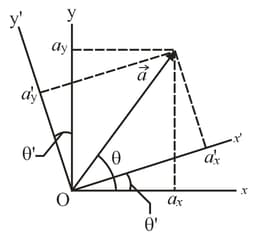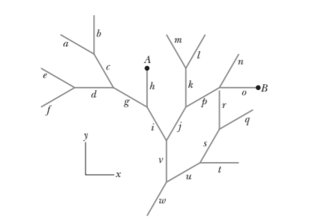Unit Vectors, Adding Vectors by Components
Important Questions on Unit Vectors, Adding Vectors by Components
In the figure, a vector with a magnitude of is directed at angle counter-clockwise from the -axis. What are the components (a) and (b) of the vector? A second coordinate system is inclined by an angle with respect to the first. What are the components (c) and (d) in this primed coordinate system?

Here are two vectors :
and
What are (a) the magnitude and (b) the angle (relative to ) of ? What are (c) the magnitude and (d) the angle of ? What are (e) the magnitude and (f) the angle of ; (g) the magnitude and (h) the angle of ; and (i) the magnitude and (j) the angle of ? (k) What is the angle between the direction of and ?
Typical backyard ants often create a network of chemical trails for guidance. Extending outward from the nest, a trail branches (bifurcates) repeatedly, with between the branches. If a roaming ant chances upon a trail, it can tell the way to the nest at any branch point. If it is moving away from the nest, it has two choices of path requiring a small turn in its travel direction, either leftward or rightward. If it is moving toward the nest, it has only one such choice. The given figure shows a typical ant trail, with lettered straight sections of length and symmetric bifurcation of . Path is parallel to the axis. What are the (a) magnitude and (b) angle (relative to the positive direction of the superimposed x axis) of an ant's displacement from the nest (find it in the figure) if the ant enters the trail at point A? What are the (c) magnitude and (d) angle if it enters at point B ?

Two beetles run across flat sand, starting at the same point. Beetle runs due east, then north of due east. Beetle also makes two runs, the first is east of due north. What must be (a) the magnitude and (b) the direction of its second run if it is to end up at the new location of beetle ?
If and . Then what are, in unit-vector notation, (a) and (b) ?
What is the sum of the following four vectors in (a) unit-vector notation, (b) as magnitude, and (c) as an angle?
Starting from an oasis, a camel walks in a direction south of west and then walks towards the north to a second oasis. What is the direction from the first oasis to the second oasis?
Vector which is directed along an -axis, is to be added to vector . Which has a magnitude of . The sum is a third vector that is directed along the -axis, with a magnitude that is times that of . What is that magnitude of ?
If and , what is the vector having the same magnitude as that of and parallel to ?
(a) What is the sum of the following four vectors in unit-vector notation? For that sum what are (b) the magnitude, (c) the angle in degrees, and (d) the angle in radians?
An ant, crazed by the sun on a hot Texas afternoon, darts over an -plane scratched in the dirt. The and components of four consecutive darts are the following, all in centimeters . The overall displacement of the four darts has the -components . What are (a) and (b) ? What are the (c) magnitude and (d) angle(relative to the positive direction of the -axis) of the overall displacement?
An explorer is caught in a whiteout (in which the snowfall is so thick that the ground cannot be distinguished from the sky) while returning to the base camp. He was supposed to travel due north for , but when the snow clears, he discovers that he actually traveled at north of due east. (a) How far and (b) in what direction must he now travel to reach the base camp?
In a game of lawn chess, where the pieces are moved between the centres of squares that are each on edge, a knight is moved in the following way: two squares forward, one square right ward, two squares leftward, one square forward, two squares forward, one square leftward. What are (a) the magnitude and (b) the angle (relative to “forward”) of the knight's overall displacement for the series of three moves?
In the sum , vector has a magnitude of and is angled counter clockwise from the direction and vector has a magnitude of and is angled counter clockwise from the direction. What are (a) the magnitude and (b) the angle (relative to ) of ?
Three vectors , and , each have a magnitude of and lie in a plane. Their directions relative to the positive direction of the -axis are , and , respectively. What is
(a) the magnitude and the angle of the vector ?
(b) the magnitude and the angle of ?
(c) the magnitude and the angle of a fourth vector , such that ?

